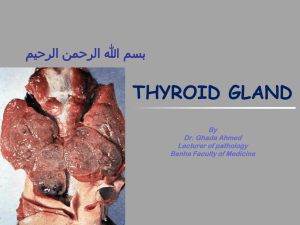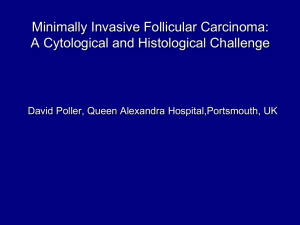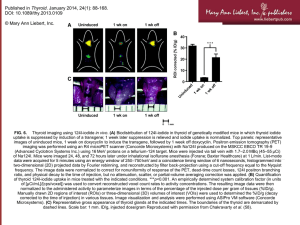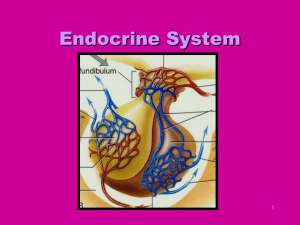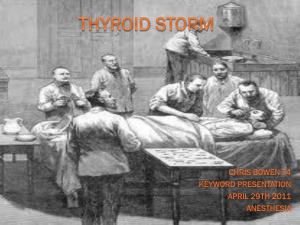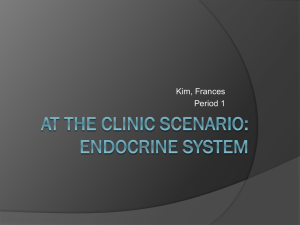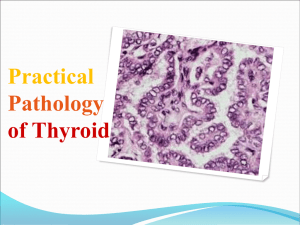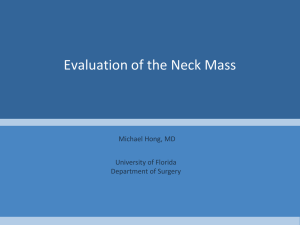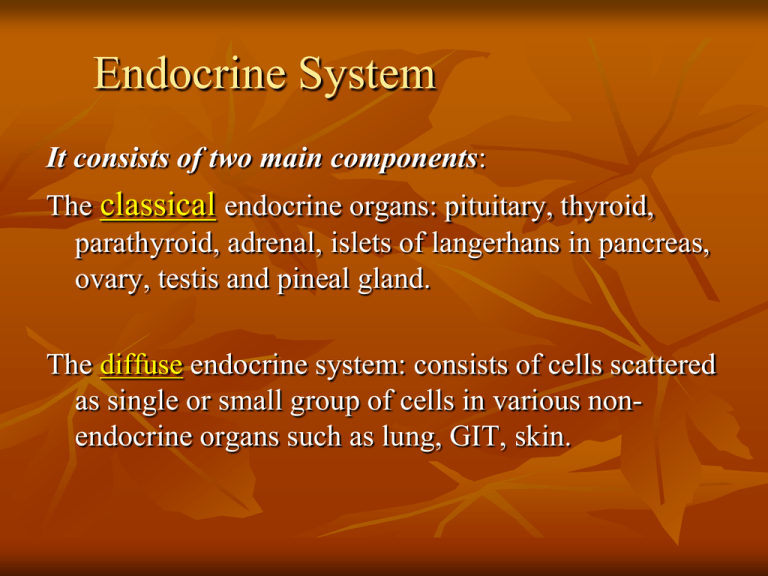
Endocrine System
It consists of two main components:
The classical endocrine organs: pituitary, thyroid,
parathyroid, adrenal, islets of langerhans in pancreas,
ovary, testis and pineal gland.
The diffuse endocrine system: consists of cells scattered
as single or small group of cells in various nonendocrine organs such as lung, GIT, skin.
The pituitary gland and hypothalamus
The pituitary gland:
Wt. about 600 mg
The pituitary gland consists of:
anterior pituitary(adenohypophysis) and
posterior pituitary (neurohypophysis).
Anterior pituitary secretes growth hormone,
prolactin, TSH, ACTH, FSH and LH .
Posterior pituitary secretes oxytocin and
ADH (vasopressin).
The normal microscopic appearance of the pituitary gland is
shown here. The adenohypophysis is at the right and the
neurohypophysis is at the left.
The normal microscopic appearance of the adenohypophysis is shown here.
The adenohypophysis contains three major cell types: acidophils(40%),
basophils(10%), and chromophobes(50%). The staining is variable, and to
properly identify specific hormone secretion, immunohistochemical
staining is necessary. A simplistic classification is as follows:
The pink acidophils secrete growth hormone (GH) and prolactin (PRL)
The dark purple basophils secrete corticotrophin (ACTH), thyroid
stimulating hormone (TSH), and gonadotrophins: follicle stimulating
hormone-luteinizing hormone (FSH and LH)
The pale staining chromophobes have few cytoplasmic granules, but may
have secretory activity.
Pathology of adenohypophysis
(Tumors):
Pituitary adenoma: most common lesion of anterior
pituitary, it divided into microadenoma (<15 mm in
diameter) and macroadenoma (>15 mm in diameter).
Effects or clinical features:
Endocrine effect due to hypersecretion of specific hormones.
Local pressure symptoms of large tumor causing
compression on surrounding structure, optic chiasma,optic
nerve, causing visual disturbance
pressure atrophy on adjacent normal gland lead to
hypopituitarism.
Enlargement and erosion of the floor of the sella turcica are
common findings and important radiological signs.
Pituitary adenoma.
The circumscribed mass lesion present here in the sella turcica is a
pituitary adenoma. Though pituitary adenomas are benign, they
can produce problems either from a mass effect (usually visual
problems from pressing on the optic chiasm and/or headaches) or
from production of hormones such as prolactin or ACTH.
This is a microadenoma of the anterior pituitary. Such
microadenomas may appear in 1 to 5% of adults. These
microadenomas rarely have a significant hormonal output that
leads to clinical disease.
The microscopic appearance of the pituitary adenoma is
shown here. Note the monotonous appearance of these small
round cells with small round nuclei and pink to blue
cytoplasm. The cells may be arranged in nests or cords and
endocrine tumors also have prominent vascularity.
Other tumors
Pituitary carcinoma: extremely rare
Craniopharyngioma :Most patients with
craniopharyngioma are in the first or second
decade of life.
Its location is usually suprasellar, although it
may occupy the sella as well
Metastatic tumors :from breast, lung ,GIT.
Posterior lobe is mostly affected, anterior lobe
rarely involved.
A craniopharyngioma is seen here at medium and high power. It is
derived from remnants of Rathke's pouch and forms an expanding mass
arising in the sella turcica that erodes bone and infiltrates into
surrounding structures. They are difficult to eradicate, even though they
are composed of histologically appearing squamoid and columnar
epithelium lining cystic spaces filled with oily fluid.
Other pathology;
Inflammatory conditions
Circulatory disturbances (Sheehan's
syndrome):
necrosis of anterior lobe due to severe postpartum hemorrhage after labour and the
patient develop after that hypopituitarism.
Hyperfunction of adenohypophysis
Hypersecretion of GH: Acromegaly and
gigantism.
ACTH: Cushing’s disease.
Prolactin: hyperprolactinemia
Acromegaly and gigantism:
Cause: pituitary adenoma.
Gigantism:
when hypersecretion of GH occur in children
before closure of epiphysis result in
proportional increase in length and thickness
of bones with delayed in epiphyseal fusion. If
excess of GH persists after epiphyseal closure
causing feature of acromegaly.
Acromegaly:
occur when hyper-secretion of GH occur after fusion
of epiphysis in adult.
clinical features; enlargement of extremities, overgrowth of bone, and soft tissue, large hand and feet,
enlargement of nose and lower jaw (prognathism),
cardiomegally, hypertension, D.M., osteoarthritis,
kyphosis, increased sweating, 30-40% have hyperprolactinaemia leading to galactorrhoea.
Cushing’s disease:
hypersecretion of ACTH result in adrenal
gland hyperplasia with excessive secretion of
glucocorticoids by adrenals resulting in
Cushing’s syndrome .
Causes of ACTH hypersecretion:
ACTH-cell adenoma.
ACTH-cell hyperplasia.
Ectopic ACTH secretion
Hyperprolactinemia:
Causes:
1.
Adenoma (prolactinoma).
2.
destructive lesion of hypothalamus.
3.
drugs (methyldopa, phenothiazine).
4.
physiological type in pregnancy.
In female it results in amenorrhea, infertility,
galactorrhoea,
in men it is usually asymptomatic, may cause
loss of libido, infertility, impotence.
Hypopituitarism:
Causes:
1.
2.
3.
4.
5.
6.
7.
8.
9.
Pituitary tumor with pressure atrophy
Sheehan’s syndrome in developing countries
Pituitary surgery or radiotherapy
Trauma
Inflammation (tuberculosis, sarcoidosis, syphilis)
Autoimmune disease
Histiocytosis X
Craniopharyngioma
Metastatic tumors
Neurohypophysis:
ADH: reabsorption of water by renal tubules and
concentration of urine.
Its deficiency causes diabetes insipidus: polyuria,
polydipsia with diluted urine which differentiated it from
psychogenic polydipsia. Causes: head injury, surgical
trauma, destructive lesion of hypothalamus (sarcoidosis,
histiocytosis-X), tumors, idiopathic.
Excessive secretion of ADH cause inappropriate secretion
of ADH, water retention causing hyponatraemia,
hypoosmolarity resulting in vomiting, muscle cramps,
weakness, central edema which may lead to coma, death.
Causes: ectopic secretion of ADH by small cell CA. of the
lung, pneumonia, head injury, meningitis, subarachnoid
hemorrhage and idiopathic.
Hypothalamus:
1.
2.
Tumors:
Gliomas and germinomas.
Gangliocytoma
Histologically: this lesion is composed of a
mixture of mature neurons, astrocytes, and
oligodendrocytes arranged with a varying
degree of organization.
Thyroid gland
Normal thyroid gland :This is the
normal appearance of the thyroid gland on the
anterior trachea of the neck. The thyroid gland has a
right lobe and a left lobe connected by a narrow
isthmus. The normal weight of the thyroid is 10 to 30
grams. It cannot easily be palpated on physical
examination.
Normal thyroid seen microscopically consists of follicles
lined by an epithelium and filled with colloid .This normal
thyroid follicle is lined by a cuboidal follicular epithelium with
cells that can add or subtract colloid depending upon the
degree of stimulation from TSH (thyroid stimulating hormone)
released by the pituitary gland. As in all endocrine glands, the
interstitium has a rich vascular supply into which hormone is
secreted.
Congenital abnormalities:
1.
2.
3.
Congenital absence of thyroid (aplasia) causes
cretinism.
Ectopic thyroid gland: lingual thyroid, along
midline in neck: sublingual, suprahyoid, infrahyoid
or lateral position in neck (lateral aberrant thyroid)
which always represent lymph node metastasis
from thyroid carcinoma (usually papillary
carcinoma) rather than ectobia. Rare sites
esophagus, larynx, trachea, soft tissues of the neck.
Thyroglossal fistula and thyroglossal cyst in
midline of the neck lined by respiratory or
squamous epithelium, contain thyroid tissue and
lymphoid tissue in its wall.
Thyroid diseases present either as thyroid enlargement
(goiter: diffuse or nodular) or as excess (Hyperthyroidism) or
deficiency (hypothyroidism) of thyroid hormones.
Hyperthyroidism: Clinically called thyrotoxicosis due to
hypersecretion of thyroid hormones and presents with signs of
hypermetabolism and excessive stimulation of the sympathetic
system (patient present with weight loss, but increased
sensitivity to circulatory adrenaline, and there is increased
appetite,patient is nervous, irritable with heat intolerance,
excessive sweating, fine tremor, tachycardia, atrial fibrillation,
which may lead to cardiac failure, eye signs include; lid-lag and
lid-retraction.
Causes:
1.
2.
3.
4.
Grave’s disease is the most common cause in
80-85% of cases.
Toxic nodular goiter 10% of cases.
Thyroid adenoma 5-10% of cases.
Other causes: Early Hashimoto’s thyroiditis,
pituitary adenoma secrete TSH, exogenous
thyroid hormone and large doses of iodine
give to patient with nontoxic nodular goitre
Hypothyroidism: Deficiency of thyroid hormones in adult is
called myxoedema and in infant and early childhood is called
cretinism.
Myxedema: dry waxy swelling of the skin of the extremities and
face. patient is lethargic, feel cold, with constipation,
psychosis, skin and hair are dry, coarse facial feature due to
deposition of mucopolysaccharide in dermis, and there is
pain, parasthesia (involvement of nerves), voice is gruff
(involvement of larynx), increased weight, increased serum
cholesterol, bradycardia, pericardial effusion .
Cretinism: mental retardation, dwarfism, coarse facial features,
a protruding tongue and umbilical hernia.
Causes of hypothyroidism:
1.
2.
3.
4.
5.
6.
7.
8.
Autoimmune thyroiditis such as Hashimoto’s thyroiditis
(most common cause in adult) and primary myxoedema.
Congenital: aplasia or hypoplagia.
Iatrogenic: following thyroidectomy, radiation therapy.
Secondary hypothyroidism due to hypopituitarism.
Severe iodine deficiency (in endemic areas).
Dietary: goitrogenes in food
Drugs: propylthyouracil, lithium.
Genetic causes; include; dyshormogenetic goiter, due to
absence of enzymes involved in synthesis of thyroid
hormones.
Pendred’s syndrome (dyshormogenesis+deafness+mutism).
Goiter:
is enlargement of the thyroid. It is either diffuse or
nodular, nontoxic or toxic.
Nontoxic goiter :
Commonest lesion of thyroid gland, causing enlargement of
thyroid as a compensatory hyperplasia by increase TSH due
to defect in the synthesis of thyroid hormones.
It is of two types:
1.
Endemic goiter
2.
Sporadic goiter
Endemic goiter: Occurrence of nontoxic goiter in more than
10% of population. It is always related to iodine deficiency.
Usually occurs in mountainous areas and areas remote from
the sea, it is due to iodine deficiency in food and water, but its
incidence has decreased upon introduction of ionized salt.
Morphological features is the same for
sporadic and endemic goiter.
Nodular goiter
This patient was euthyroid. This represents the most common cause for an
enlarged thyroid gland and the most common disease of the thyroid.
MNG characterized by
1. Asymmetrical enlargement.
2. Multiple nodules of variable size.
3. Secondary degenerative changes: hemorrhage, fibrosis, cystic degeneration filled
Microscopic features of nontoxic
goiter:
Early stage, diffuse hyperplasia of follicles with scanty colloid
(parenchymatous goiter), this is followed by accumulation of
colloid with involution of epithelium (colloid goiter).
Later on, nodules formation of variable size contain colloid
separated by fibrous tissue (multinodular colloid goiter)
associated with degenerative changes: cystic changes,
hemorrhage, fibrosis, calcification.
Multinodular goiter:
Different sized follicles some are dilated and lined by flattened
epithelium (indicate inactivity), filled with colloid,others lined by
normal or hyperplastic epith.
In some cases, one nodule prominently
enlarged (dominant nodule) confused with
tumor. In some cases of long standing
multinodular goiter especially in elderly, show
picture of hyperthyroidism (toxic nodular
goiter).
Autoimmune thyroid diseases:
These characterized by:
1.
Presence of circulating auto antibodies to thyroid
tissue.
2.
Lymphocytic infiltration with destruction of thyroid
tissue and formation of lymphoid follicles with
germinal centers.
3.
It may be associated with other autoimmune
diseases such as Addison’s disease, D.M., SLE,
rheumatoid arthritis, pernicious anemia.
they include:
Hashimoto’s thyroiditis:
this disease due to presence of auto antibodies
(antithyroglobulin, anti-microsomal antibody).
Increase in HLA-DR5 and B5 suggests genetic
predisposition.
1-2% led to B-cell lymphoma.
Increase risk of papillary carcinoma.
This symmetrically small thyroid gland demonstrates atrophy.
This patient was hypothyroid. This is the end result of
Hashimoto's thyroiditis. Initially, the thyroid is enlarged and
there may be transient hyperthyroidism, followed by a
euthyroid state and then hypothyroidism with eventual atrophy
years later.
Here is a low power microscopic view of a thyroid with
Hashimoto's thyroiditis. Note the lymphoid follicle at the right
center. This is an autoimmune disease and often
antithyroglobulin and antimicrosomal antibodies can be
detected. Other autoimmune diseases such as Addison's
disease or pernicious anemia may also be present.
Hashimoto’s thyroiditis:
1- Hürthle cells: large pink cells at the center and right
2- The lymphoid follicle with germinal center is at the left.
Grave’s disease:
It’s characterized by diffuse thyroid hyperplasia and
hyperthyroidism (diffuse toxic goiter)
Its incidence increase in HLA-DR3 individuals
suggests genetic predisposition.
It results from presence of autoantibodies to TSH
receptors cause their activation and stimulate thyroid
hormone secretion causing hyperthyroidism. These
antibodies are called thyroid stimulating
immunoglobulin (TSI: stimulate thyroxin -T4
synthesis). TGI lead to gland hyperplasia and
enlargement .
Grave’s disease (difuse toxic goiter)
A diffusely enlarged thyroid gland associated with hyperthyroidism is known as
Grave's disease. Note the infoldings of the hyperplastic epithelium line by tall
columnar thyroid epithelium with clear vacuoles in the colloid next to the
epithelium where the increased activity of the epithelium to produce increased
thyroid hormone has led to scalloping out of the colloid .
Other autoimmune diseases
Primary myxoedema.
Lymphocytic thyroiditis.
Other type of thyroiditis:
De Quervain’s thyroiditis(granulomatous, or
subacute thyroiditis).
Riedel’s thyroiditis
DeQuervian’s thyroiditis: This is subacute granulomatous thyroiditis
which probably follows a viral infection and leads to a painful enlarged
thyroid. This disease is usually self-limited over weeks to months and the
patients return to euthyroid state. Note the foreign body giant cells with
destruction of thyroid follicles.
Riedel’s thyroiditis
Very rare disease of unknown etiology,
characterized by extensive replacement of
thyroid tissue by dense fibrous tissue causing
hardness of the gland (stony hard) with
extension of fibrous tissue outside the gland
cause fixation of thyroid to adjacent structures
(iron collar) such as: trachea, recurrent
laryngeal nerve (clinically mimic Carcinoma),
some cases associated with retroperitoneal or
mediastinal fibrosis
Thyroid tumors:
1. Tumors arise from follicular epithelial cells:
benign: follicular adenoma (majority of
thyroid tumor)
malignant: follicular carcinoma, papillary
carcinoma and anaplastic carcinoma.
2. Tumors arise from C cells: medullary
carcinoma.
Follicular adenoma:
Commonest thyroid tumor mainly in females over 30 years.
Adenoma usually presents with nonfunctioning (cold) nodule
but may be cause hyperthyroidism (toxic adenoma) which is
hot nodule on thyroid scan.
The nodule is painless, if large may produce local symptoms.
Gross:Adenoma usually solitary encapsulated nodule
(3-10 cm) and compressing surrounding thyroid tissue.
Histopathological features: Adenoma consists of uniform
follicles contain colloid, surrounded by fibrous capsule
without capsular or vascular invasion with or without nuclear
pleomorphism or atypia (endocrine atypia).
Adenoma with microfollicles and little colloid called fetal
adenoma, while those with macrofollicles filled with colloid
called colloid adenoma.
If it consists of Hürthle cells (Hürthle cell adenoma).
All have the same behavior.
Follicular neoplasm ( follicular adenoma histologically)
A solitary neoplasm that is surrounded by a thin white capsule. It is
sometimes difficult to tell a well-differentiated follicular carcinoma from a
follicular adenoma. Thus, patients with follicular neoplasms are treated with
subtotal thyroidectomy just to be on the safe side.
Follicular adenoma
Normal thyroid follicles appear at the lower right. The follicular adenoma
is at the center to upper left. This adenoma is a well- differentiated
neoplasm because it closely resemble normal tissue. The follicles of the
adenoma contain colloid, but there is greater variability in size than
normal.
Papillary carcinoma:
All papillary tumors of thyroid are malignant, it is the commonest
malignant tumor of the thyroid =80% of all carcinomas.
Occur most often in middle aged females. may be solitary or multifocal
within the gland. It may be well circumscribed and even encapsulated,
or illdefined.
This tumor commonly metastasize by lymphatic rather than by blood,
and lymph node metastasis in the neck present in about half of cases
and the presence of cervical lymph node metastasis doesn’t affect the
prognosis.
Prognosis is good; 10 year survival is 85%. Papillary carcinoma may
be very small (occult) and patient present with cervical lymph node
metastasis (previously called lateral aberrant thyroid).
Histology: tumors have papillary structures with fibrovascular core
lined by cuboidal cells with characteristic nuclear features; clear or
empty nuclei with ground glass or (Orphan Annie) nuclei,
intranuclear pseudoinclusion and grooved nuclei.
Psammoma bodies: concentrically calcified structures are often
present within the papillae.
Variants?
Papillary carcinoma This neoplasm can be multifocal, as
seen here, because of the propensity to invade lymphatics within
thyroid, and lymph node metastases are common. The larger mass is
cystic and contains papillary excresences.
This is the microscopic appearance of a papillary carcinoma of
the thyroid. The fronds of tissue have thin fibrovascular cores.
The fronds have a papillary pattern. There is no such thing as a
papillary adenoma, and all papillary neoplasms of the thyroid
should be considered malignant.
Papillary carcinoma This is another papillary carcinoma of thyroid.
Note the small psammoma body in the center. The cells of the neoplasm
have clear nuclei. Papillary carcinomas are indolent tumors that have a long
survival, even with metastases. The most favorite site of metastasis is to
local lymph nodes in the neck. In fact, some papillary carcinomas may first
present as nodal metastases.
Follicular carcinoma:
1.
2.
15 % of all thyroid cancer, more common in endemic
area(dietary iodine deficiency), suggesting that, in some
cases,nodular goiter may predispose to ca. more in females,
occurs in 5th decade(older than papillary ca), blood metastasis
is more than lymphatic metastasis, especially to bone and
lung.
Prognosis is poorer than papillary carcinoma, 5 year survival
50%.
It is of two types:
Microinvasive carcinoma (minimally invasive carcinoma):
Encapsulated tumor and differentiated from follicular
adenoma by presence of fibrous capsular invasion and/or
vascular invasion. prognosis is good.
Widely invasive carcinoma: Widely spread of tumor within
thyroid gland and outside the gland with prominent blood
vessels invasion. prognosis is poor.
Medullary carcinoma:
Neuroendocrine neoplasm, 5% of thyroid cancer, either sporadic 80%
or familial 20% as part of multiple endocrine neoplasia-type ІІA or B.
Sporadic type is usually unilateral(solitary) and occurs in 5th-6th
decade.
Familial type is usually bilateral and multifocal associated with C-cell
hyperplasia; occurs in young adults and even in children.
Gross appearance: it is solitary nodule or multiple lesions ±
hemorrhage and necrosis.
Histology: tumor consists of polygonal to spindle cells form nests, cords
or even follicles with amyloid deposition in stroma.
Medullary carcinoma spread by both blood and lymphatic.
Prognosis: familial type is more aggressive and fatal tumor especially
MEN-2B.
This tumor produce calcitonin and other hormones, e.g.: VIP.
Medullary carcinoma . At the center and to the right is a
medullary carcinoma of thyroid. At the far right is pink hyaline
material with the appearance of amyloid. These neoplasms
are derived from the thyroid "C" cells and, therefore, have
neuroendocrine features such as secretion of calcitonin.
Here the amyloid stroma of the medullary thyroid carcinoma has been
stained with Congo red. Medullary carcinomas can be sporadic or
familial. The familial kind are associated with multiple endocrine
neoplasia syndrome.
Anaplastic carcinoma:
Highly malignant tumor, form<5% of thyroid
carcinoma, mainly occurs in elderly women
usually present with short history and grow
rapidly, locally invasive and early metastasis
by blood and lymphatics. Tumor is poorly
differentiated with spindle and bizarre giant
cells represent poorly differentiated follicular
or papillary carcinoma.
There is no resemblance to normal thyroid tissue-hence
the term "anaplastic" to characterize this thyroid carcinoma.
Note the elongated spindle cells.This is the most aggressive
thyroid cancer, and luckily the least common.
Etiology of thyroid carcinoma:
1.
2.
3.
4.
5.
Iodine deficiency: May determine the type of tumor but not
as causative agent. Follicular carcinoma more in endemic
area where iodine is deficient (nodular goiter).
Radiation: To head and neck in children for treatment of
lymphoma or other lesions (tonsillar enlargement, acne) may
increase the risk for development of thyroid carcinoma
especially papillary carcinoma. (Atomic bomb in Japan,
Ionizing radiation in Chernobyl also increase inc. of
papillary carcinoma).
Chromosomal translocation, t(2;3) recently found in a
proportion of follicular carcinomas.
RET protooncogen mutation presents in (95%) of MEN-II.
Inactivating mutation of TP53 in anaplastic carcinoma.
Lymphoma:
Primary NLH of thyroid is B-cell lymphoma; mainly
in elderly patients.
80% of cases are associated with Hashimoto’s
disease.(1-2% of thyroiditis….).
It’s usually of diffuse large cell type of follicular
center cell and it’s regarded as MATL-lymphoma.
The cells of lymphoma infiltrate the thyroid follicles
(lymphoepithelial lesion).
It has poor prognosis.
Solitary thyroid nodule:
Benign lesions: Adenomas or localized non
neoplastic conditions (e.g., nodular hyperplasia ,
simple cysts, or foci of thyroiditis).
Carcinomas are uncommon >1%.
Clinical criteria suggest neoplastic nodule:
1. solitary.
2. solid.
3. nodules in young patients.
4. in males.
5. Cold.
Definite dx. By FNAC AND HISTOLOGICAL
STUDY.
Parathyroid glands
Parathyroid glands
They are 4 glands located on posterior surface
of thyroid gland (3-4mm in size) consist of 2
types of cells:
Chief cells.
Oxyphil cells.
secretes PTH (parathyroid hormone) acts on
bone and kidney to increase the Ca+2 level in
blood.
Hyperparathyroidism:
Primary: excess secretion of PTH causing
hypercalcemia (one of most common endocrine
disorders). MEN-1, 2A
Causes:
1.
Single parathyroid adenoma : commonest cause(8090%), solitary and encapsulated confined to single
gland (others are normal or shrunken).
2.
Primary hyperplasia(10-20%): all glands are
diffusely involved.
3.
Parathyroid carcinoma (less than 1% of cases).
Clinical features
Painful bones:# due to osteoporosis or osteitis
fibrosa cystica.
Renal stones: polyuria, nephrocalcinosis.
Abdomnal goans: constipation, peptic ulcers,
G.stones, pancreatitis…
Psychic moans: depression, seizures.
Morphology:
Adenoma: soft, tan encapsulated nodule
composed of uniform, polygonal chief cells
with few nests of oxiphil cells), a rim of
compressed parathyroid tissue separated by a
fibrous capsule at the edge. Adipose tissue is
inconspicuous within the adenoma.
No invasion or metastases.
Other organs: skeletal; osteitis fibrosa cystica,
brown tumor. Renal; UT-stones,
nephrocalcinosis. Metastatic calcification in
stomach, lungs , myocardium and blood
Parathyroid adenoma: which is the most common cause for
primary hyperparathyroidism. A rim of normal parathyroid
tissue admixed with adipose tissue cells is compressed to the
right and lower edge of the adenoma.
Parathyroid hyperplasia : Three and one-half glands have been
removed (only half the gland at the lower left is present).
Parathyroid hyperplasia is the second most common form of
primary hyperparathyroidism, with parathyroid carcinoma the
least common form.
Secondary hyperparathyroidism
Causes:
1.
Chronic renal failure.
2.
Malabsorption syndrome.
3.
Vitamin D deficiency.
4.
Pregnancy and lactation
The glands are hyperplastic : diffuse or multinodular.
in minority of patients parath. activity may become
autonomous and excesive with resultant
hypercalcemia termed tertiary hyperparathyroidism
Hypoparathyroidism:
Causes:
1.
2.
3.
Surgical removal of glands during
thyroidectomy.
DiGeorge syndrome: congenital aplasia of
thymus and parathyroid gland lead to
decrease in T-cell number and
hypocalcaemia seen in infant and children.
Autoimmune disease.
Adrenal (Suprarenal) glands
Adrenal (Suprarenal) gland: consists of cortex and medulla.
Each adult adrenal gland weighs from 4 to 6 grams.
Cortex: is mesoderm in origin¸ yellow in color¸ consisting of
three zones:
1.
Outer: zona glomerulosa produce aldosterone.
2.
Intermediate zone: zona fasciculata produce
glucocorticoids.
3.
Inner zone: zona reticularis produce sex hormones mostly
(androgen) and less estrogen.
Adrenal medulla: is neuroectoderm in origin, brown in color
consisting of chromaffin cells, nerve fibers and sympathetic
ganglion cells produces catecholamines (adrenaline and noradrenaline).
Normal adrenal gland
Adrenal cortical tumors:
1. Adrenal adenoma:
is commonly seen in post partum examination as
small encapsulated yellow nodule¸ Unilateral or
bilateral, consists of cells similar to adrenal cortex,
the majority are non-functioning tumor¸ some are
functioning with excessive secretion of cortisol,
aldosterone¸ and sex hormones.
This adrenal gland removed surgically in a patient with Cushing's
syndrome has been sectioned in half to reveal an adenoma. Some
remaining atrophic adrenal is seen at the right. The adenoma is
composed of yellow firm tissue just like adrenal cortex. This neoplasm is
well-circumscribed. Histologically, it is composed of well-differentiated
cells resembling cortical fasciculata zone. It is benign.
Microscopically, the adrenal cortical adenoma at the right
resembles normal adrenal fasciculata. The capsule is at the left.
There may be some cellular pleomorphism.
2. Cortical carcinoma:
Most important sign to distinguish between benign
and malignant cortical tumor is the presence of
metastasis. Other signs include tumor >100gms, large
non-functioning tumor and tumor secrets androgen
are most likely to be malignant.
Histology: Very difficult to differentiate between
benign and malignant tumor on morphology alone but
presence of high mitotic activity, necrosis, capsular
and vascular invasion, and marked anaplasia are more
favorable signs of malignancy.
This is a large adrenal cortical carcinoma which is displacing
the left kidney downward. Such neoplasms are usually
functional (secreting corticosteroids or sex steroids). They
have a poor prognosis.
This high power microscopic appearance of an adrenal cortical
carcinoma demonstrates that the neoplasm closely resembles
normal adrenal cortex. It is difficult to determine malignancy in
endocrine neoplasms based upon cytology alone. Thus, invasion
(as seen here in a vein) and metastases are the most reliable
indicators. Luckily, most endocrine neoplasms are benign
adenomas.
Adrenocortical hyperfunction: It produces 3 main
syndromes:
1.
2.
3.
Cushing’s syndrome: hypersecretion of
cortisol.
Hyperaldosteronism: primary called Conn’s
syndrome.
Adrenogenital syndrome: excessive
secretion of androgen.
Cushing’s syndrome:
because of its effect on the metabolism results in many signs
and symptoms. It occurs most commonly in women with
central (truncal) obesity, moon face, buffalo hump, muscle
wasting of limbs with weakness, osteoporosis may cause
vertebral collapse, skin atrophy with bruising and striae, skin
pigment(in extra-adrenal Cushing syndrome), hypertension,
impaired GTT with hyperglycemia, glucosuria, wound healing
delayed, menstrual disorder, hirsutism, amenorrhea, and
virilization, depression, psychosis.
Causes:
1.
2.
3.
4.
Long term therapy by corticosteroids:(Iatrogenic) is the
most common cause e.g.: patients with rheumatoid arthritis
or nephrotic syndrome.
Cushing’s disease: pituitary Cushing’s syndrome, due to
excessive secretion of ACTH by pituitary adenoma or
hyperplasia.
Adrenal tumors and nodular hyperplasia(Adrenal): either
adenoma or carcinoma, adrenal tumors are commonest cause
of Cushing’s syndrome in children, especially carcinoma.
Increase serum level of the glucocorticoids and ACTH
secretion is decrease due to feedback and this cause atrophy
of contralateral adrenal gland and tissue adjacent to tumor.
Ectopic ACTH syndrome(paraneoplastic): secretion of
ACTH by non-pituitary tumors such as: small cell
carcinoma of lung, carcinoid tumor, and islet cell tumor of
Center = Normal Adrenal gland
Upper=adrenal atrophy (Addison’s disease or long-term corticosteroid therapy)
Lower=The adrenals with bilateral cortical hyperplasia. This could be due to a
pituitary adenoma secreting ACTH (Cushing's disease), or Cushing's syndrome from
ectopic ACTH production, or idiopathic.
Hyperaldosteronism:
1.
2.
3.
primary or secondary.
Primary hyperaldosteronism (Conn´s syndrome):
causes:
Adenoma of zona glomerulosa 80% of cases.
Bilateral hyperplasia of zona glomerulosa
15% of cases.
Carcinoma (rare).
Secondary hyperaldosteronism:.
1.
2.
3.
4.
excessive stimulation of renin-angiotensin system stimulates
aldosterone secretion.
Causes:
Renal disease with renal ischemia.
Heart failure with edema.
Liver cirrhosis.
Renin secreting tumor (rare).
* To differentiate secondary from primary type both
plasma level of aldosterone and renin are high in
secondary type.
Adrenogenital syndrome:
Causes:
1.
Adrenal tumors: tumors with excessive secretion of
androgen cause virilism in females (hirsutism and
clitoris enlargement) and in males cause precocious
puberty. These tumors are mostly carcinoma.
2.
Congenital adrenal hyperplasia: it is rare inborn error of
metapolism, AR condition, enzyme deficiency involved in
synthesis of glucocorticoids this result in plasma
reduction of cortisol , hypersecretion of ACTH this in
turn causes bilateral adrenal hyperplasia with excess
production of androgen commonest type is 21hydroxylase deficiency cause virilism in female and in
male lead to precocious puberty also there is decrease in
synthesis of aldosterone.
Adrenocortical hypofunction: either acute or chronic.
Acute adrenocortical insufficiency:
May occur in septicemia particularly in children with meningococcal
septicemia (Waterhouse-Friedrichsen syndrome) less commonly with other
infections. Presentation with hypotensive shock, high level K, low level Na
and glucose, hypotension, collapse and death, also patients have high fever
and skin rashes. Adrenal gland show hemorrhage with extensive necrosis of
cortex.
other causes:
Chronic adrenal insufficiency may be complicated by acute failure
(Addisonian crisis) due to increase demand of cortisone as in infection or
trauma.
Sudden withdrawal of corticosteroid TRT from patient with long term
therapy (tapering of therapy by corticosteroid is mandatory in those
patients).
The patient with Waterhouse-Friderichsen syndrome has sepsis
with DIC and marked purpura.
These adrenals are black-red from extensive hemorrhage
in a patient with meningococcemia. This produces the
Waterhouse-Friderichsen syndrome
This is the microscopic appearance of the
adrenals with meningococcemia. There is
marked hemorrhagic necrosis with acute adrenal
insufficiency.
Chronic adrenocortical insufficiency (Addison's
disease):
Causes:
1.
Autoimmune adrenalitis: commonest cause (75%), atrophy of
adrenal cortex with lymphocyte infiltration, medulla is normal
may be associated with autoimmune disease of thyroid, DM
and pernicious anemia.
2.
Tuberculosis: second most common cause. Adrenal enlarged
with caseation and calcification medulla destroyed. Other
infection: AIDS, histoplasmosis.
3.
Amyloidosis.
4.
Metastatic tumor: especially lung and breast carcinomas.
5.
Sarcoidosis.
Addison's disease (chronic) adrenocortical
insufficiency. Here are Congo red stained deposits of amyloid in the
adrenal cortex. Amyloid may collect in adrenal as well as other organs.
Adrenal medulla:
1.
Pheochromocytoma: Tumor of adrenal medulla
secretes catecholamines causing paroxysmal
hypertension, palpitation, severe head ache,
sweating, hyperglycemia, occur in young adults, it
has rule of 10:
10% bilateral.
10% non-functioning.
10% in children.
10% malignant.
10% familial (MEN-2).
This large adrenal neoplasm has been sectioned in half. Note the greytan color of the tumor compared to the yellow cortex stretched around it
and a small remnant of remaining adrenal at the lower right. This
patient had episodic hypertension. This is a tumor arising in the adrenal
medulla--a pheochromocytoma.
There is some residual adrenal cortical tissue at the
lower center right, with the darker cells of
pheochromocytoma seen above and to the left.
Neuroblastoma: small round cell tumor of children
arises from primitive cells of sympathetic system.
Commonly seen in children below 5 years old,
common site is adrenal medulla,other sites are
posterior mediastinum,retroperitoneum. it is highly
malignant tumor with lymph node metastasis and
blood metastasis to the bone.
Others: Neurofibroma, ganglioneuroma, and
myelolipoma.
Neuroblastoma
This is a microscopic appearance of neuroblastoma, which is one of the "small round
blue cell" tumors. These neoplasms can reach a large size in the retroperitoneum before
detection. They often contain areas of necrosis and calcification.


